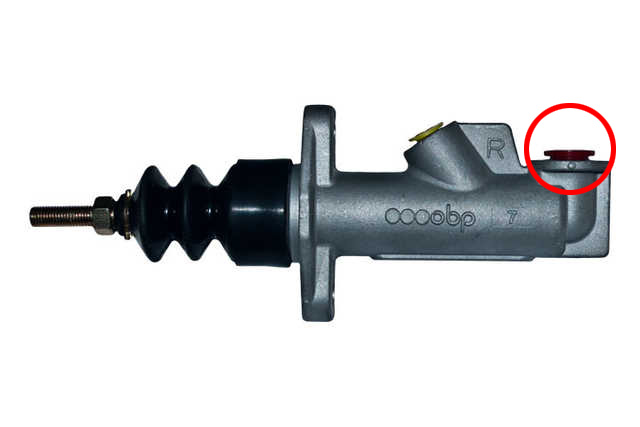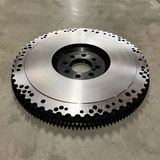Master brake cylinder: Choose the right size & thread

Choosing the right brake master cylinder can seem like an impossibility. - It is not like that and you will understand why in a simple way now.
What you need to choose the right brake master cylinder
- Calculate size of the master brake cylinder
- Different sizes of the master brake cylinder
- Most common setup of master brake cylinders
- Select brake cylinder - List
- Master brake cylinder - outlet (pressure side)
- Master brake cylinder - inlet
- Master brake cylinder installation
- Brake cylinder is broken during assembly
1 ▼
Calculate size of the master brake cylinder
3 steps that show how you calculate what size a brake cylinder should be.1. Fluid intake to brake caliper
How much fluid does the caliper require when braking?
In this example, we use a brake system with a brake bias bar. A 0.625" front master cylinder and a 0.625" rear. Pistons in the caliper measure 54mm in diameter both rear and front.
- Calculate piston area
Use the formula Pi*r*r = piston area
Pi = 3,14
r= radius (radius=diameter/2)
3,14*27*24=2289
In other words a 54mm piston need 2289mm2 fluid to move 1mm. - Number of pistons
Now we know that a piston needs 2289mm2 of fluid to move 1mm.
Just calculate the number of pistons that belong to a brake cylinder.
In this case, we have 4 pistons for one brake cylinder. (Single-piston calipers is calculated as two pistons.)
4x2289=9156
All four pistons of a brake cylinder therefore need a total of 9156mm2 to move one mm - Result
Now we know that a circuit needs 9156mm2 to move one millimeter.
NOTE - Single piston calipers count as two pistons. In other words, you take the piston area x2
2. Pumpable fluid Brake cylinder
How much fluid can a .625" brake cylinder move?
- Pumpable liquid
0,625" = 5/8" = 15,87mm
Use the formula Pi*r*r = piston area
Pi = 3,14
r= radius (radius=diameter/2)
3,14*7,935*7,935=197mm2
A 0,625" brake cylinder can move 197mm3 fluid per millimeter. - Brake cylinder stroke
A brake cylinder has about a 30mm stroke.
30x197= 5910mm3 - Result
Now we know that a 0.625" cylinder max can move 5910mm3 of liquid
3. Match brake caliper and brake cylinder
Calculate whether a brake cylinder fits.
Our four pistons need 9156mm2 to move 1mm.
So the pumpable liquid from a 0.625" cylinder is not enough.
But the pistons rarely move a millimeter to push the brake pads against the brake disc, rather 0.5mm. This is not a science and may differ between installations and other parameters. Sometimes it can be 0.4 and sometimes 0.6mm or completely different numbers. Here we see a big factor that shot it is not an exact science to count on.
Expect the pistons to move 0.5mm to push the brake pads against the brake disc.
9156mm*0.5= 4578mm3
Now we see that a 0.625" cylinder is enough to brake the car.
About 3/4 stroke of our master brake cylinder is used for this.
The result:
When the push-rod on the master brake cylinder is pushed in 3/4th, the brake pads are pressed against the brake disc.
A larger brake cylinder provides more resistance in the brake pedal but less clamping force.
A smaller brake cylinder provides less resistance in the brake pedal but more clamping force.
2 ▼
Different sizes of the master brake cylinder
- 0,625" / 5/8" / 15,87mm = 5910 mm3
- 0,7" / 17,78mm = 7440 mm3
- 0,75" / 3/4" / 19,05mm = 8550 mm3
- 0,875" / 22,225mm = 11632 mm3
- 1" / 25,4mm = 15210 mm3
3 ▼
Most common setup of master brake cylinders
- 0,625" front circuit
- 0,7" rear circuit
- 0,75" clutch
4 ▼
Select brake cylinder - List
Which size you should choose can be calculated using the example above, but below is a list of which size is common for different caliper/piston sizes.
Front:
0,625" = Single-piston caliper that has a piston diameter of up to approx. 60mm
0,625" = Four-piston calipers that have a piston diameter of up to approx. 30mm
0,625" = Total piston area is up to approx. 11000mm2
If you want a more firm pedal, choose a 0.7" master cylinder.
Rear:
0,7" = Single-piston caliper that has a piston diameter of up to approx. 50mm
0,7" = Four-piston calipers that have a piston diameter of up to approx. 25mm
0,7" = Total piston area is up to approx. 9100mm2
Above are general guidelines that have worked well although personal feel plays a big role and can be decisive on which cylinder is ultimately chosen.
5 ▼
Master brake cylinder - outlet (pressure side)
Thread The outlet is angled and has 3/8"-24 thread with a concave taper at the bottom. Imperial thread has become a sort of market standard.
Seal It is possible to use fittings that seal at the bottom against the cone. These must then be concave. But it is also possible to use washer as sealing against the installation surface at the top against the brake cylinder.
Size of brake pipe used is 3/16" and size of brake hose is 1/8".

The push rod has 5/16" -20 thread
6 ▼
Master brake cylinder - inlet
Thread The inlet is located at the end of the brake cylinder and has 7/16"-20 thread with a convex taper at the bottom. Imperial thread has become a sort of market standard.
Seal It is possible to use fittings that seal at the bottom against the cone. These must then be convex. But it is also possible to use washer sealing against the installation surface at the top against the brake cylinder.
Size of brake pipe and hose used is 1/4". Sometimes 7/16" threaded together with 3/16" brake pipe is also used, so pay attention to the designations. Since the inlet is not pressurized but only flows into the master cylinder, the inner diameter of the pipe should / the hose must be at least ~6mm or 1/4" so that the liquid flow is not restricted down in a smaller pipe.

7 ▼
Master brake cylinder installation
When installing a brake master cylinder it is good to try to keep the push rod as straight as possible in relation to the body of your master cylinder. Then the pressure does not become skewed and does not stress the gaskets unevenly. Uneven pressure causes increased wear.
Also make sure that the push rod is unloaded in the rest position so that brake fluid is not prevented from flowing down into the cylinder.
8 ▼
Brake cylinder is broken during assembly
If a brake or clutch cylinder is compressed dry, the gaskets can twist or be damaged. Do not compress a brake/clutch cylinder when it is dry/new as the gaskets may stick a little to the cylinder walls and the gaskets will most likely be damaged. The cylinder is delivered very lightly oiled so it doesn't even help. Pour in brake fluid before the piston is compressed. This applies to all types of cylinders with piston construction, both brake and clutch cylinders. -OEM and aftermarket.
▼
▼
-
Brake system
- Brake system: Parts and installation
- Brake bias bar
- Brake distribution valve installation
- Brake fitting - Convex or concave
- Brake fittings (Video)
- Brake fluid information
- Brake pipe flaring
- Carbotech: Choose the right brake pads
- How to bleed your brakes?
- Master brake cylinder: What size should I have on my master brake cylinder?











































